2023 TOYOTA TUNDRA flat tire
[x] Cancel search: flat tirePage 562 of 616

5628-1. Specifications
■Temperature A, B, C
The temperature grades are A (the highest), B, and C, representing
the tire’s resistance to the ge neration of heat and its ability to dissi-
pate heat when tested under contr olled conditions on a specified
indoor laboratory test wheel.
Sustained high temperature can c ause the material of the tire to
degenerate and reduce tire life, and excessive temperature can lead
to sudden tire failure.
Grade C corresponds to a level of performance which all passeng er
car tires must meet under the Fe deral Motor Vehicle Safety Stan-
dard No. 109.
Grades B and A represent higher levels of performance on the labo-
ratory test wheel than the minimum required by law.
Warning: The temperature grades of a tire assume that it is pro perly
inflated and not overloaded.
Excessive speed, underinflation, or excessive loading, either sepa-
rately or in combination, can c ause heat buildup and possible t ire
failure.
Page 563 of 616
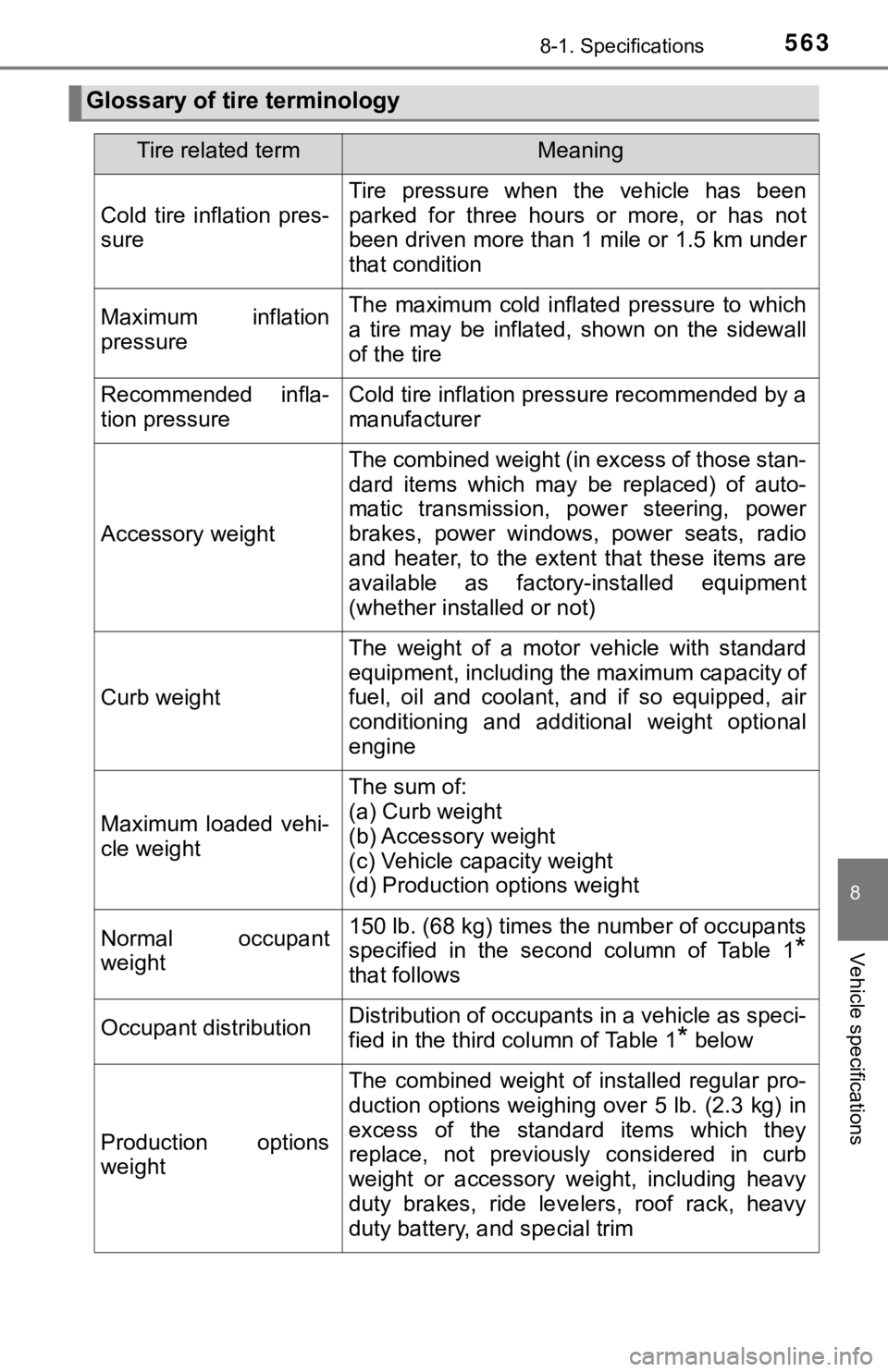
5638-1. Specifications
8
Vehicle specifications
Glossary of tire terminology
Tire related termMeaning
Cold tire inflation pres-
sure
Tire pressure when the vehicle has been
parked for three hours or more, or has not
been driven more than 1 mile or 1.5 km under
that condition
Maximum inflation
pressureThe maximum cold inflated pressure to which
a tire may be inflated, shown on the sidewall
of the tire
Recommended infla-
tion pressureCold tire inflation pressure recommended by a
manufacturer
Accessory weight
The combined weight (in excess of those stan-
dard items which may be replaced) of auto-
matic transmission, power steering, power
brakes, power windows, power seats, radio
and heater, to the extent that these items are
available as factory-installed equipment
(whether installed or not)
Curb weight
The weight of a motor vehicle with standard
equipment, including the maximum capacity of
fuel, oil and coolant, and if so equipped, air
conditioning and additional weight optional
engine
Maximum loaded vehi-
cle weight
The sum of:
(a) Curb weight
(b) Accessory weight
(c) Vehicle capacity weight
(d) Production options weight
Normal occupant
weight150 lb. (68 kg) times the number of occupants
specified in the second column of Table 1
*
that follows
Occupant distributionDistribution of occupants in a vehicle as speci-
fied in the third column of Table 1
* below
Production options
weight
The combined weight of installed regular pro-
duction options weighing over 5 lb. (2.3 kg) in
excess of the standard items which they
replace, not previously considered in curb
weight or accessory weight, including heavy
duty brakes, ride levelers, roof rack, heavy
duty battery, and special trim
Page 564 of 616
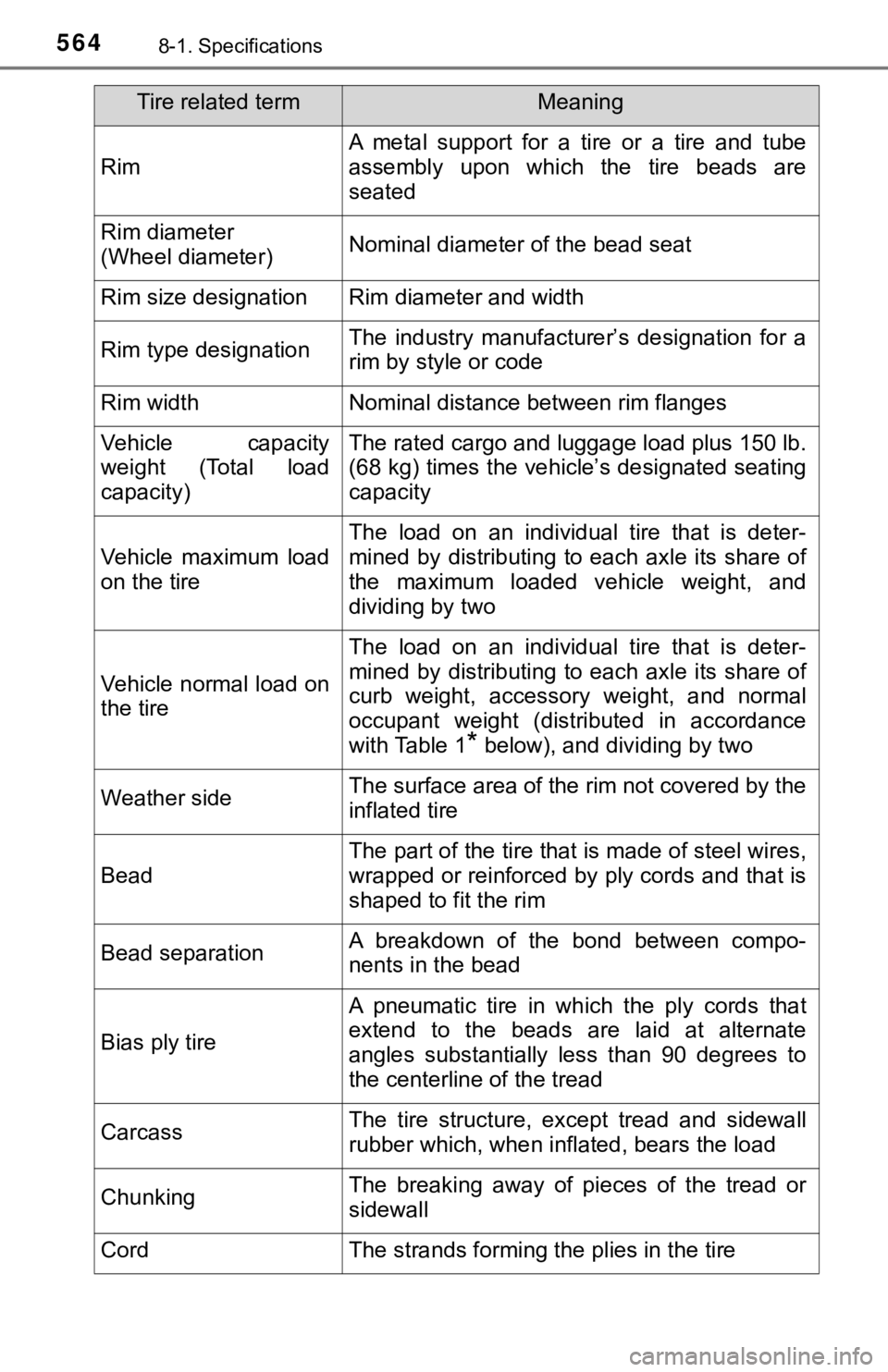
5648-1. Specifications
Rim
A metal support for a tire or a tire and tube
assembly upon which the tire beads are
seated
Rim diameter
(Wheel diameter)Nominal diameter of the bead seat
Rim size designationRim diameter and width
Rim type designationThe industry manufacturer’s designation for a
rim by style or code
Rim widthNominal distance between rim flanges
Vehicle capacity
weight (Total load
capacity)The rated cargo and l uggage load plus 150 lb.
(68 kg) times the vehicle’s designated seating
capacity
Vehicle maximum load
on the tire
The load on an individual tire that is deter-
mined by distributing to each axle its share of
the maximum loaded vehicle weight, and
dividing by two
Vehicle normal load on
the tire
The load on an individual tire that is deter-
mined by distributing to each axle its share of
curb weight, accessory weight, and normal
occupant weight (distributed in accordance
with Table 1
* below), and dividing by two
Weather sideThe surface area of the rim not covered by the
inflated tire
Bead
The part of the tire that is made of steel wires,
wrapped or reinforced by ply cords and that is
shaped to fit the rim
Bead separationA breakdown of the bond between compo-
nents in the bead
Bias ply tire
A pneumatic tire in which the ply cords that
extend to the beads are laid at alternate
angles substantially less than 90 degrees to
the centerline of the tread
CarcassThe tire structure, except tread and sidewall
rubber which, when inflated, bears the load
ChunkingThe breaking away of pieces of the tread or
sidewall
CordThe strands forming th e plies in the tire
Tire related termMeaning
Page 565 of 616
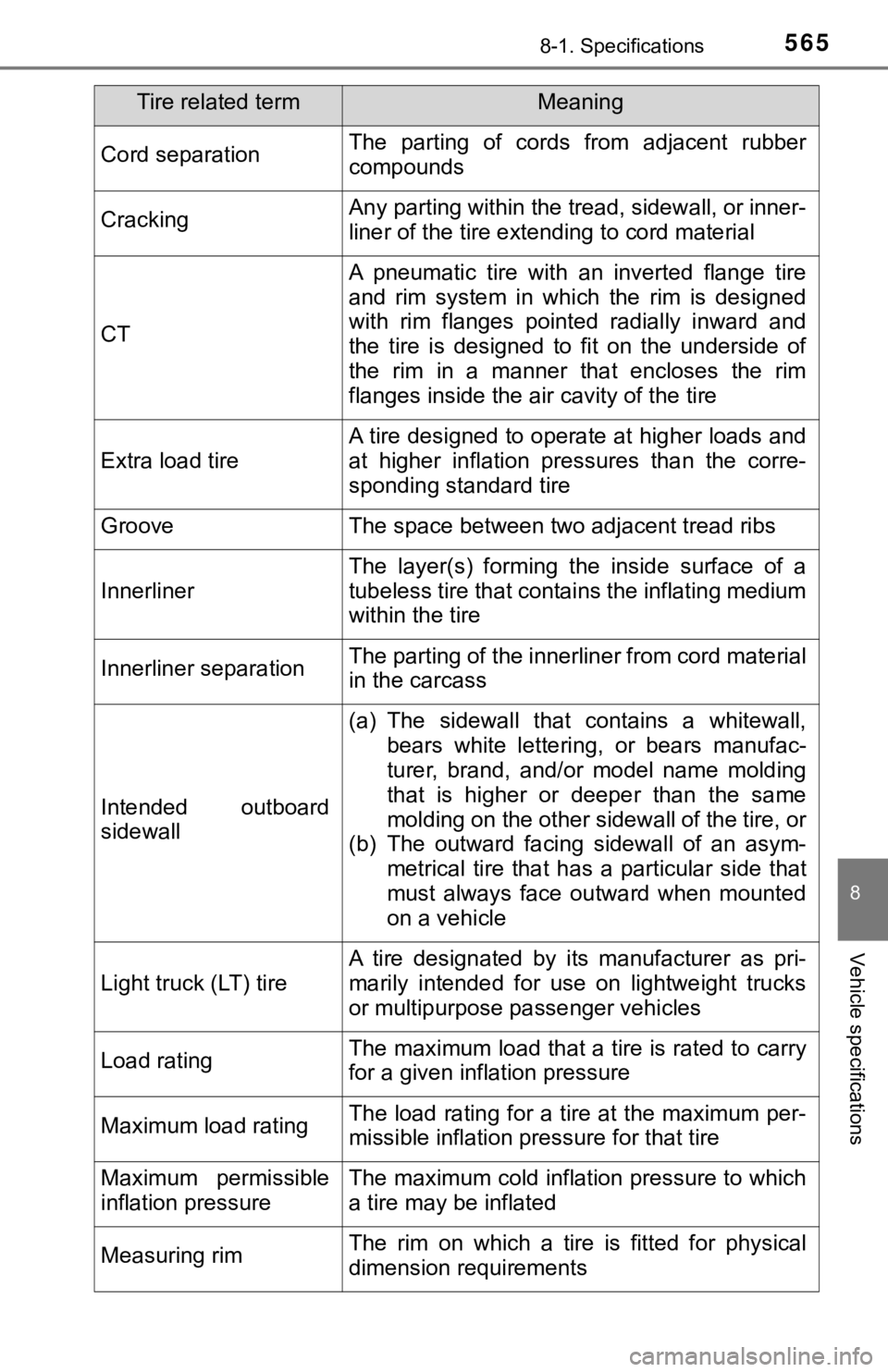
5658-1. Specifications
8
Vehicle specifications
Cord separationThe parting of cords from adjacent rubber
compounds
CrackingAny parting within the tread, sidewall, or inner-
liner of the tire extending to cord material
CT
A pneumatic tire with an inverted flange tire
and rim system in which the rim is designed
with rim flanges pointed radially inward and
the tire is designed to fit on the underside of
the rim in a manner that encloses the rim
flanges inside the air cavity of the tire
Extra load tire
A tire designed to operate at higher loads and
at higher inflation pressures than the corre-
sponding standard tire
GrooveThe space between two adjacent tread ribs
Innerliner
The layer(s) forming the inside surface of a
tubeless tire that contains the inflating medium
within the tire
Innerliner separationThe parting of the innerliner from cord material
in the carcass
Intended outboard
sidewall
(a) The sidewall that contains a whitewall,bears white lettering, or bears manufac-
turer, brand, and/or model name molding
that is higher or deeper than the same
molding on the other sidewall of the tire, or
(b) The outward facing sidewall of an asym- metrical tire that has a particular side that
must always face outward when mounted
on a vehicle
Light truck (LT) tire
A tire designated by its manufacturer as pri-
marily intended for use on lightweight trucks
or multipurpose passenger vehicles
Load ratingThe maximum load that a tire is rated to carry
for a given inflation pressure
Maximum load ratingThe load rating for a tire at the maximum per-
missible inflation pressure for that tire
Maximum permissible
inflation pressureThe maximum cold inflation pressure to which
a tire may be inflated
Measuring rimThe rim on which a tire is fitted for physical
dimension requirements
Tire related termMeaning
Page 566 of 616
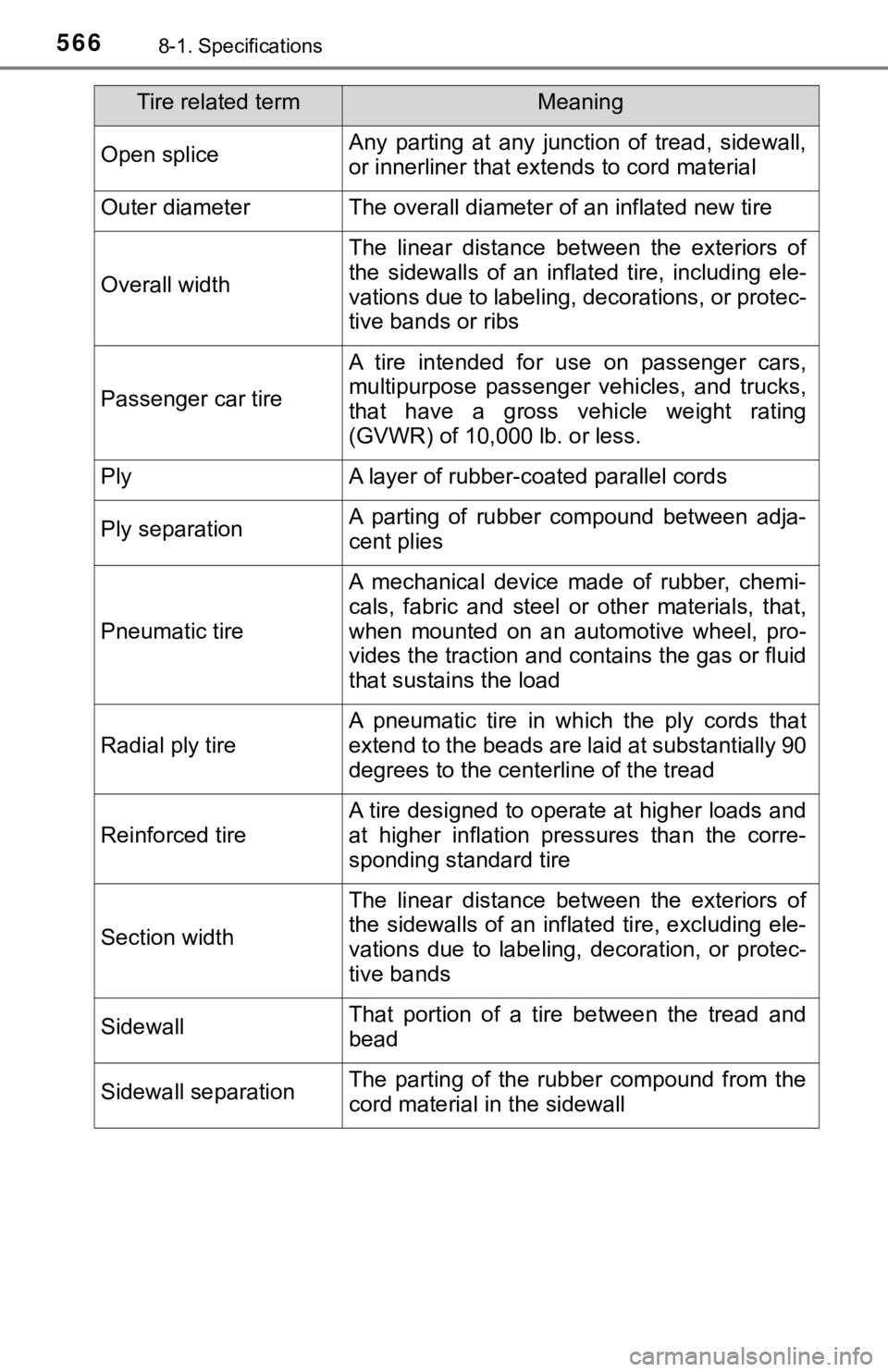
5668-1. Specifications
Open spliceAny parting at any junction of tread, sidewall,
or innerliner that extends to cord material
Outer diameterThe overall diameter of an inflated new tire
Overall width
The linear distance between the exteriors of
the sidewalls of an inflated tire, including ele-
vations due to labeling, decorations, or protec-
tive bands or ribs
Passenger car tire
A tire intended for use on passenger cars,
multipurpose passenger vehicles, and trucks,
that have a gross vehicle weight rating
(GVWR) of 10,000 lb. or less.
PlyA layer of rubber-coated parallel cords
Ply separationA parting of rubber compound between adja-
cent plies
Pneumatic tire
A mechanical device made of rubber, chemi-
cals, fabric and steel or other materials, that,
when mounted on an automotive wheel, pro-
vides the traction and co ntains the gas or fluid
that sustains the load
Radial ply tire
A pneumatic tire in which the ply cords that
extend to the beads are laid at substantially 90
degrees to the centerline of the tread
Reinforced tire
A tire designed to operate at higher loads and
at higher inflation pressures than the corre-
sponding standard tire
Section width
The linear distance between the exteriors of
the sidewalls of an inflated tire, excluding ele-
vations due to labeling, decoration, or protec-
tive bands
SidewallThat portion of a tire between the tread and
bead
Sidewall separationThe parting of the rubber compound from the
cord material in the sidewall
Tire related termMeaning
Page 599 of 616

599What to do if... (Troubleshooting)
●Did anyone inside the vehicle open a door during setting the alarm?
The sensor detects it and the alarm sounds. ( P. 88)
●Vehicles without a smart key system:
To stop the alarm, turn the engine switch to the “ON” position or start the
engine.
●Vehicles with a smart key system:
To stop the alarm, turn the engine switch to IGNITION ON mode o r start
the engine.
●When a warning light turns on or a warning message or indicator is dis-
played, refer to P. 482, 489.
●Stop the vehicle in a safe place and replace the flat tire with the spare tire.
( P. 511)
●Try the procedure for when the vehicle becomes stuck in mud, di rt, or
snow. ( P. 536)
An alarm is activated and the horn sounds
(vehicles with an alarm)
A warning light turns on or a warning message or indicator
is displayed
When a problem has occurred
If you have a flat tire
The vehicle becomes stuck
Page 603 of 616
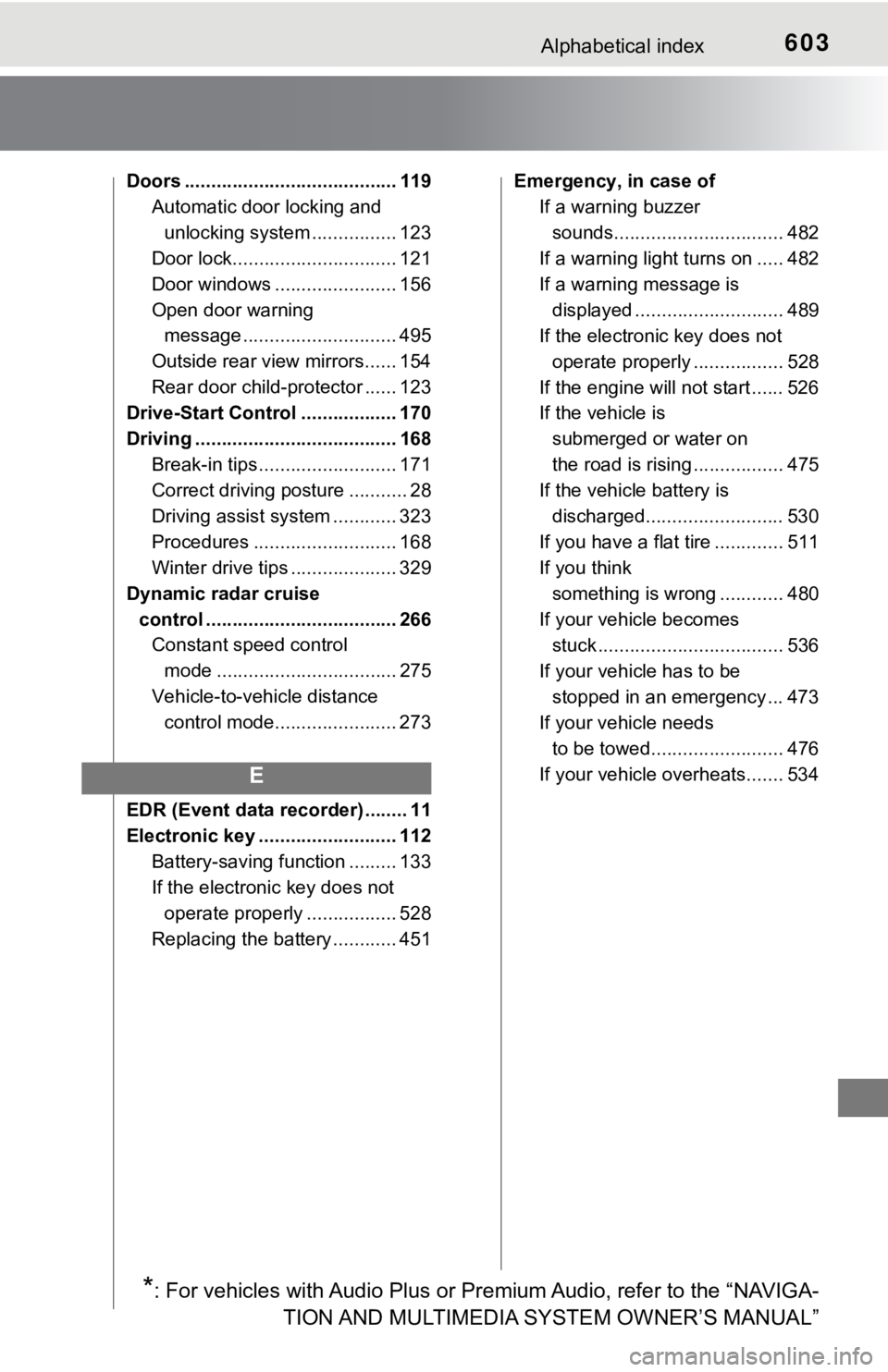
603Alphabetical index
Doors ........................................ 119Automatic door locking and unlocking system ................ 123
Door lock............................... 121
Door windows ....................... 156
Open door warning message ............................. 495
Outside rear view mirrors...... 154
Rear door child-protector ...... 123
Drive-Start Control .................. 170
Driving ...................................... 168
Break-in tips .......................... 171
Correct driving posture ........... 28
Driving assist system ............ 323
Procedures ........................... 168
Winter drive tips .................... 329
Dynamic radar cruise control .................................... 266 Constant speed control
mode .................................. 275
Vehicle-to-vehicle distance control mode....................... 273
EDR (Event data recorder) ........ 11
Electronic key .......................... 112 Battery-saving function ......... 133
If the electronic key does not operate properly ................. 528
Replacing the battery ............ 451 Emergency, in case of
If a warning buzzer sounds................................ 482
If a warning light turns on ..... 482
If a warning message is displayed ............................ 489
If the electronic key does not
operate properly ................. 528
If the engine will not start ...... 526
If the vehicle is submerged or water on
the road is rising ................. 475
If the vehicle battery is
discharged.......................... 530
If you have a flat tire ............. 511
If you think something is wrong ............ 480
If your vehicle becomes stuck ................................... 536
If your vehicle has to be stopped in an emergency ... 473
If your vehicle needs
to be towed......................... 476
If your vehicle overheats....... 534
E
*: For vehicles with Audio Plus or Premium Audio, refer to the “ NAVIGA-
TION AND MULTIMEDIA SYSTEM OWNER’S MANUAL”
Page 604 of 616

604Alphabetical index
Emergency flashers ................ 472
EngineCompartment ........................ 419
Engine switch................ 202, 205
Hood ..................................... 417
How to start the engine......................... 202, 205
Identification number ............ 543
If the engine will not start ...... 526
Ignition switch (engine switch) ........... 202, 205
Immobilizer system ................. 78
Overheating .......................... 534
Engine coolant ......................... 423 Capacity ................................ 547
Checking ............................... 423
Preparing and checking before winter....................... 329
Engine coolant temperature
gauge........................................ 98
Engine immobilizer system ...... 78
Engine oil ................................. 421 Capacity ................................ 545
Checking ............................... 421
Oil level warning message .... 492
Oil pressure warning message ............................. 490
Preparing and checking
before winter....................... 329
Engine switch (ignition switch)............. 202, 205
Engine switch light (ignition switch light) ............ 353
Event data recorder (EDR) ........ 11 Flat tire ..................................... 511
Floor mats .................................. 26
Fluid
Automatic transmission ........ 549
Brake .................................... 550
Power steering...................... 550
Washer ................................. 430
Fog lights ................................. 229 Replacing light bulbs ............ 464
Switch ................................... 229
Wattage ................................ 553
Four-wheel drive system ........ 303
Front passenger occupant classification system .............. 48
Front personal lights............... 354
Front seats ............................... 139 Adjustment............................ 139
Cleaning ............................... 406
Correct driving posture ........... 28
Head restraints ..................... 145
Seat heaters ......................... 351
Front side marker lights
Light switch ........................... 220
Replacing light bulbs ............ 462
Wattage ................................ 553
Front turn signal lights Replacing light bulbs ............ 463
Turn signal lever ................... 218
Wattage ................................ 553F